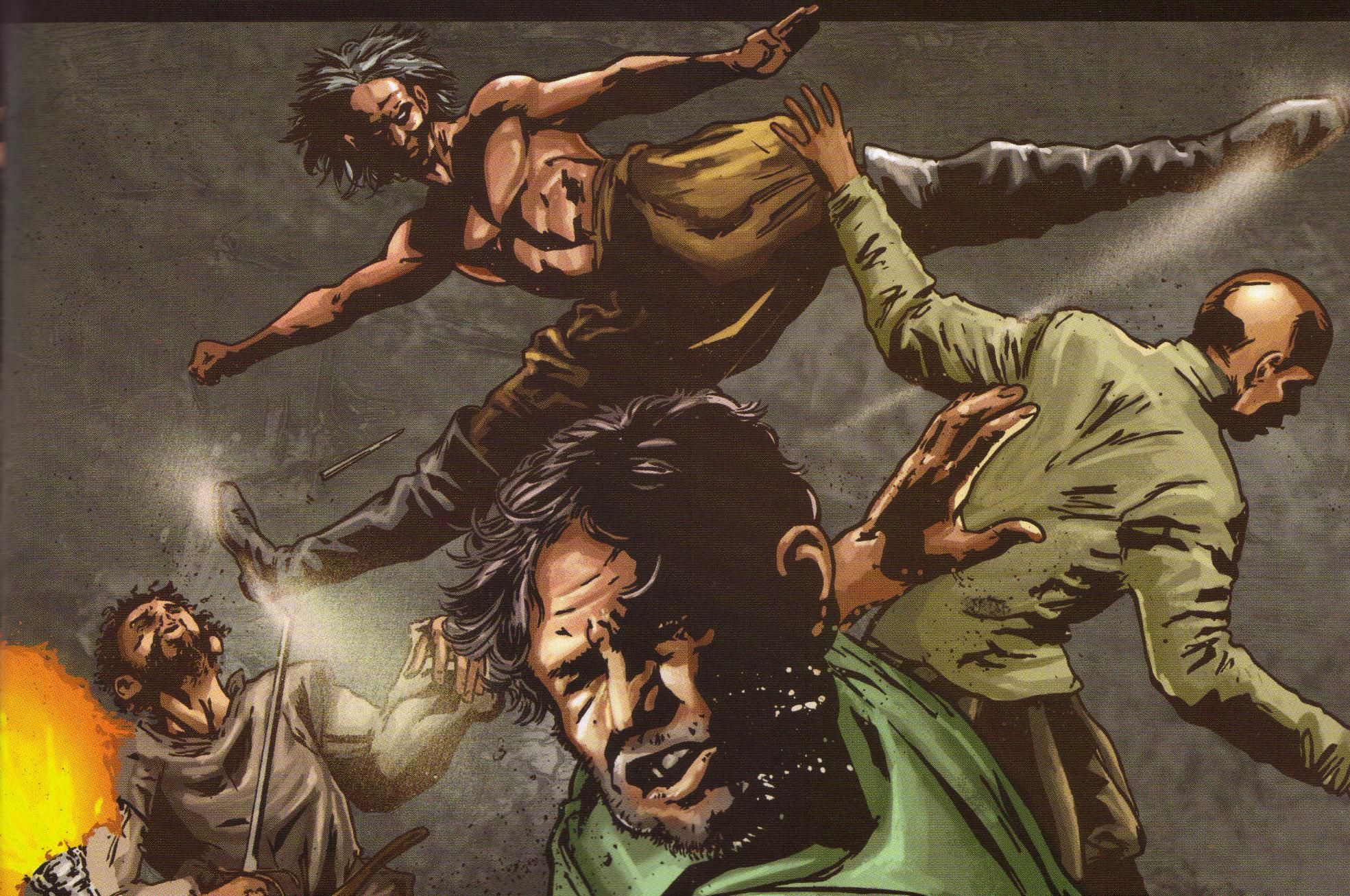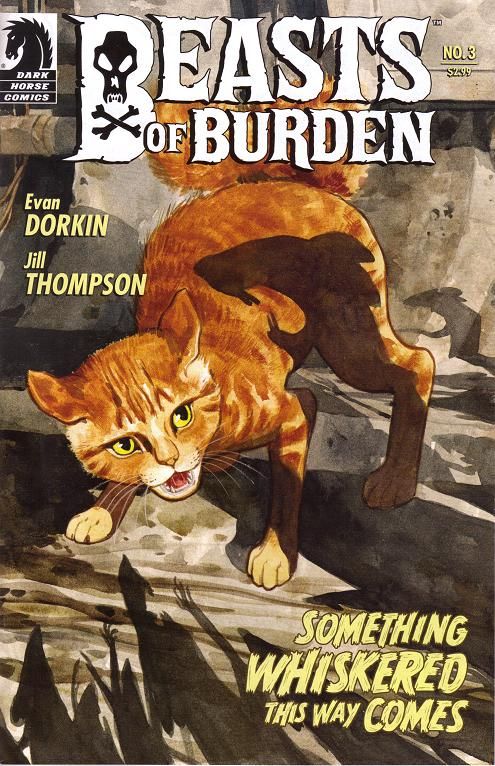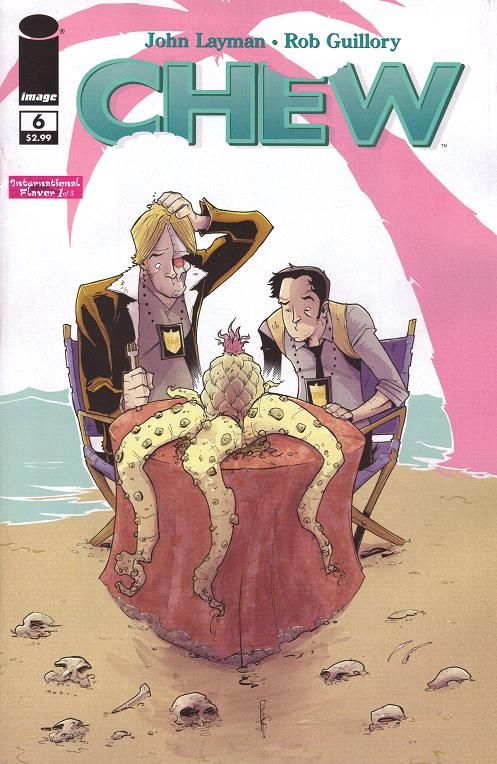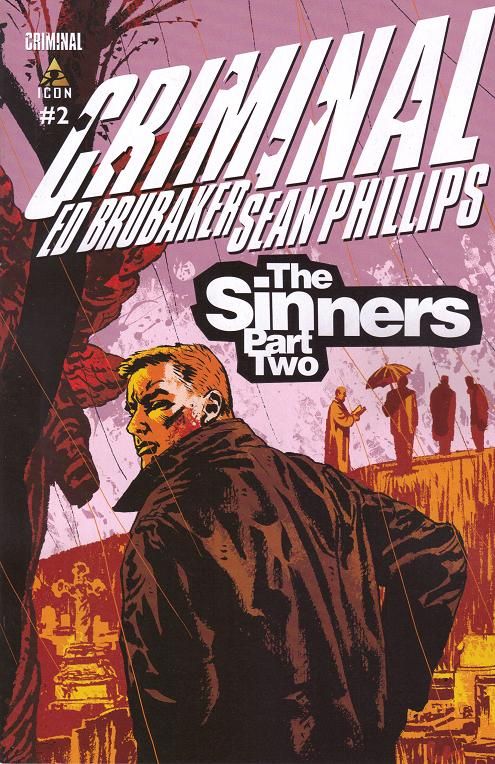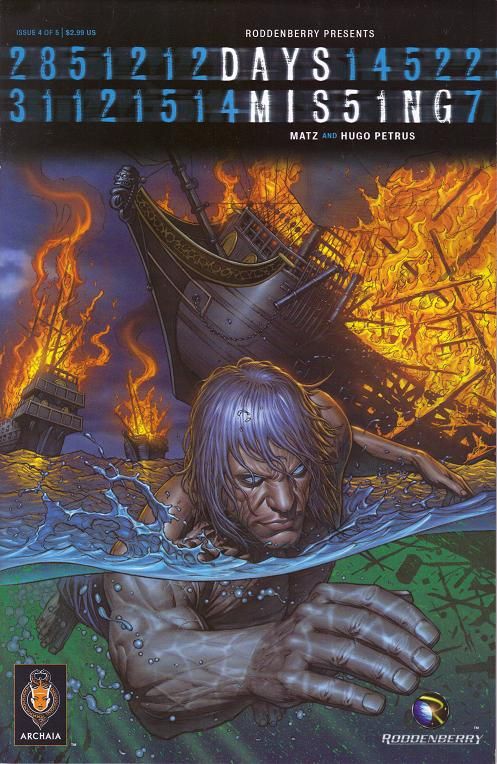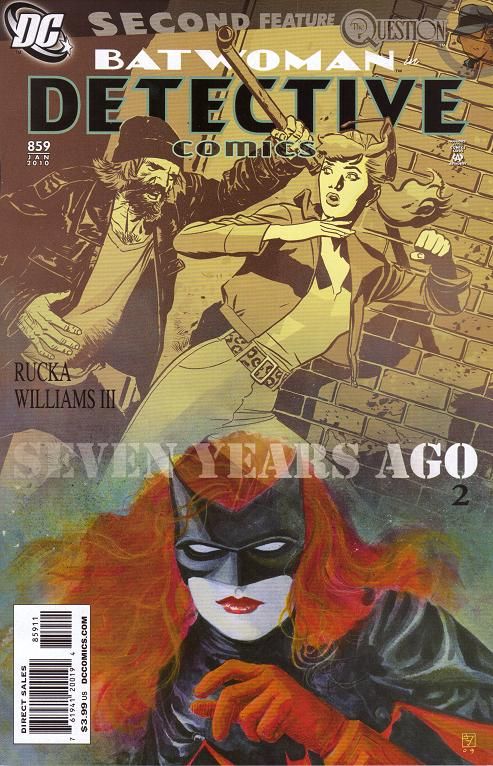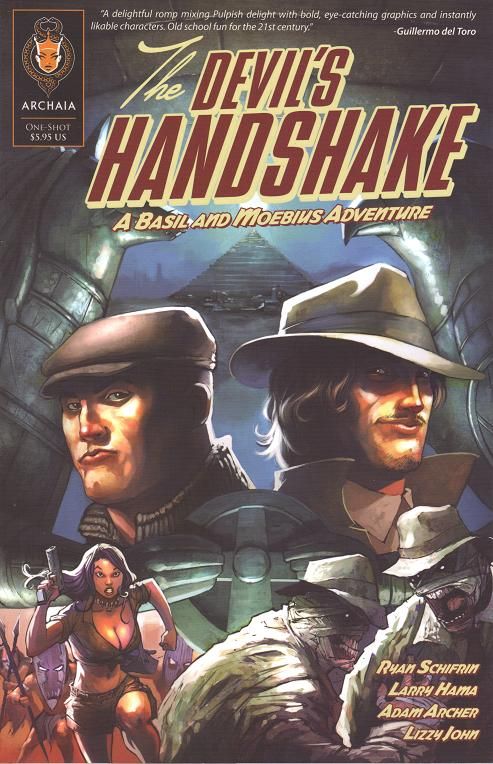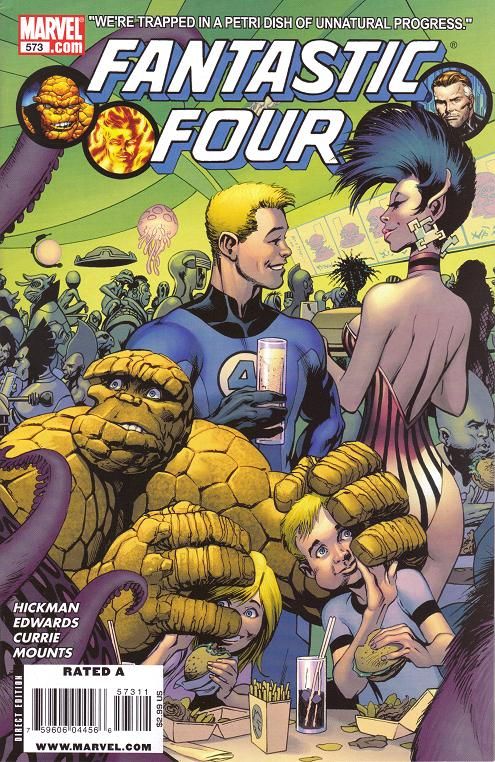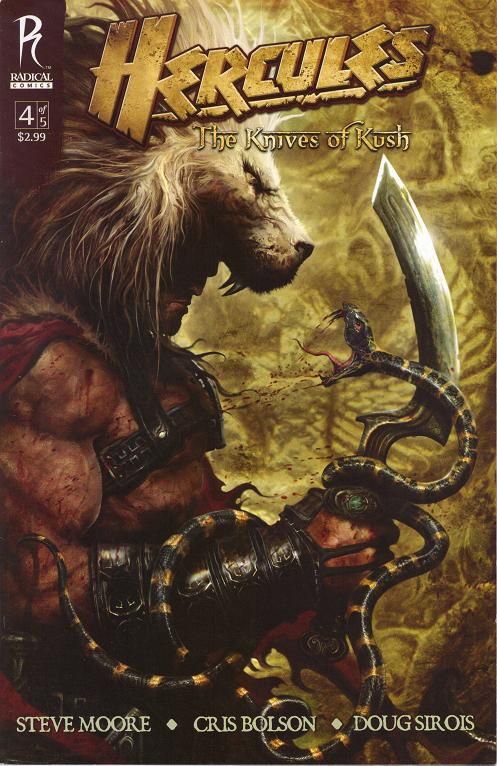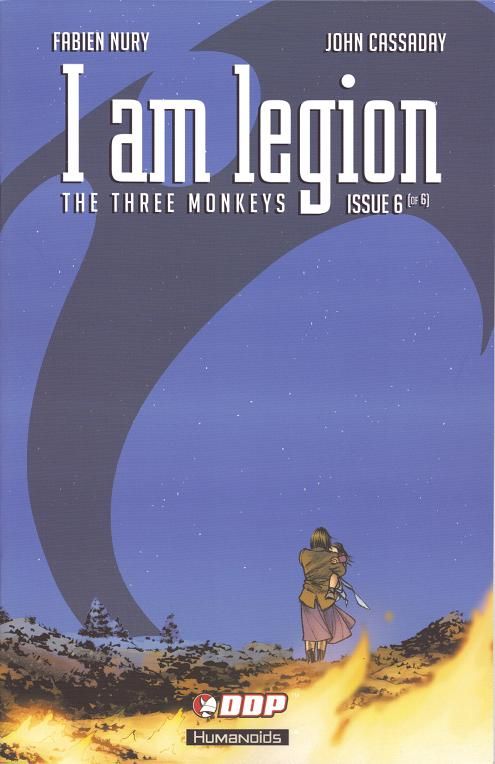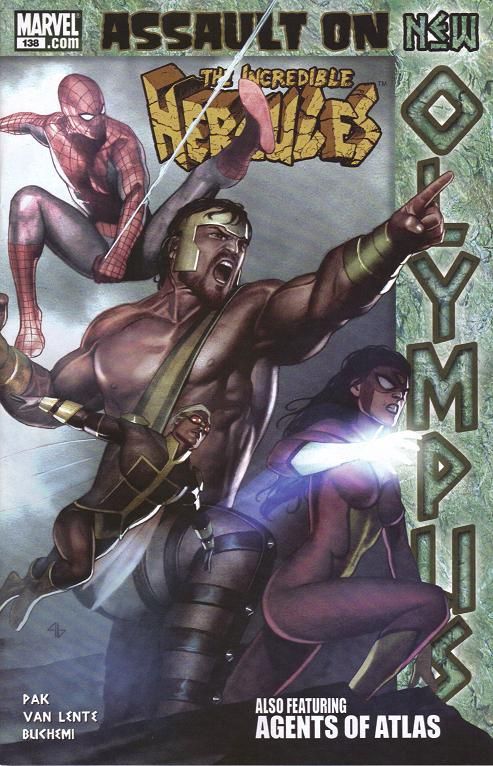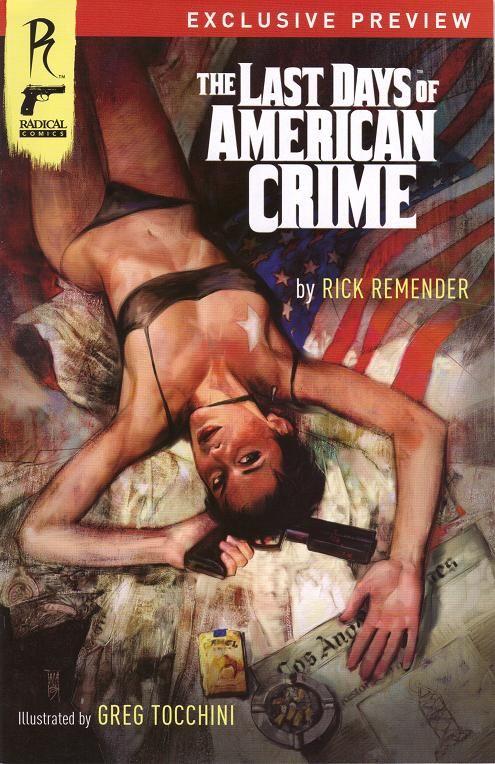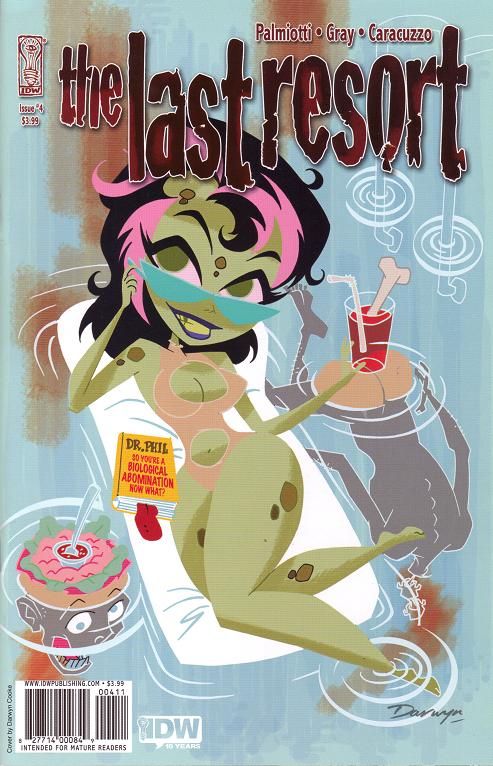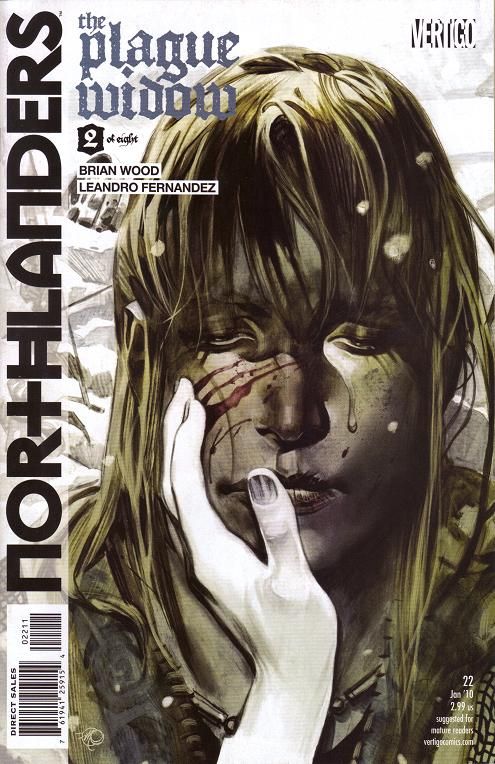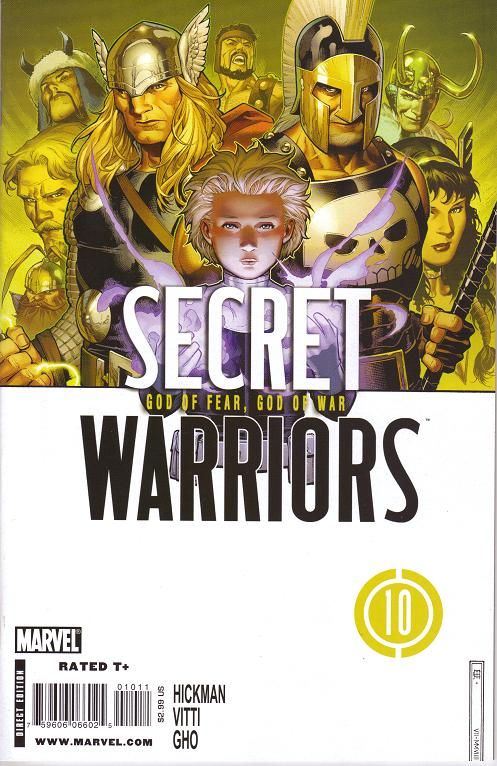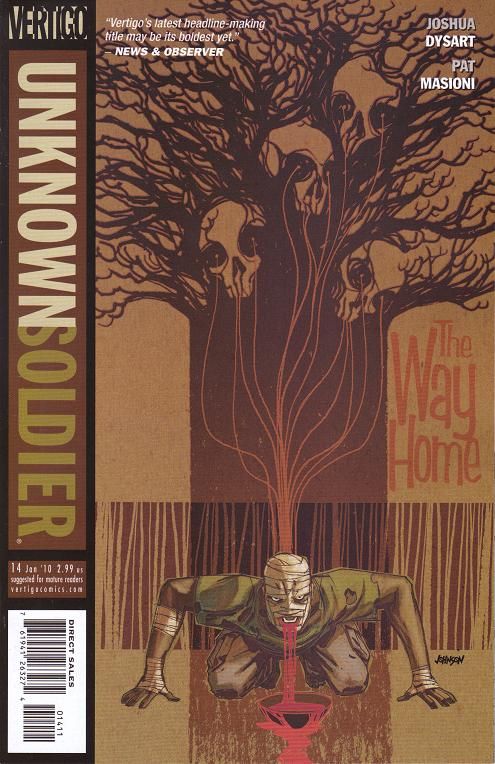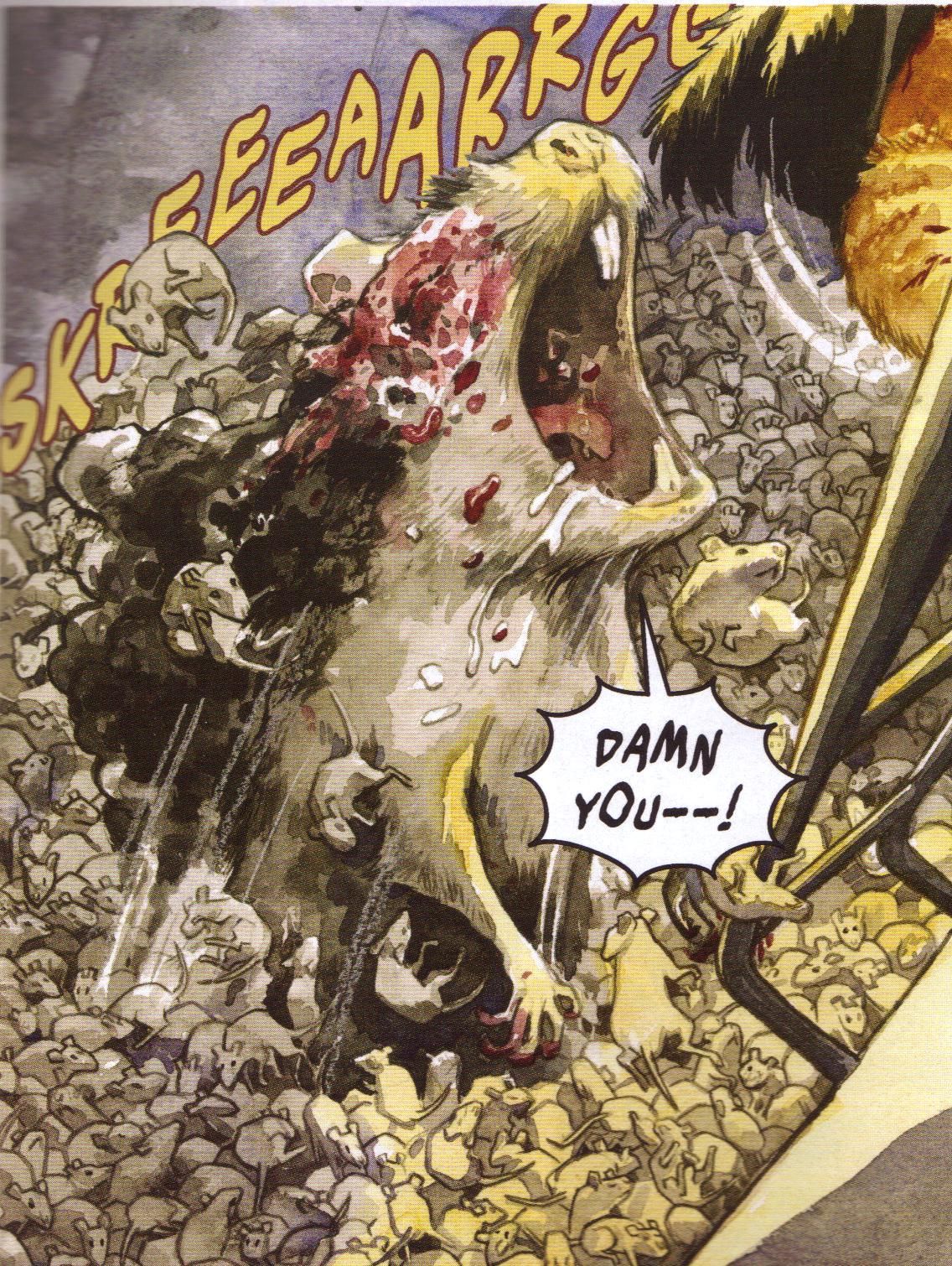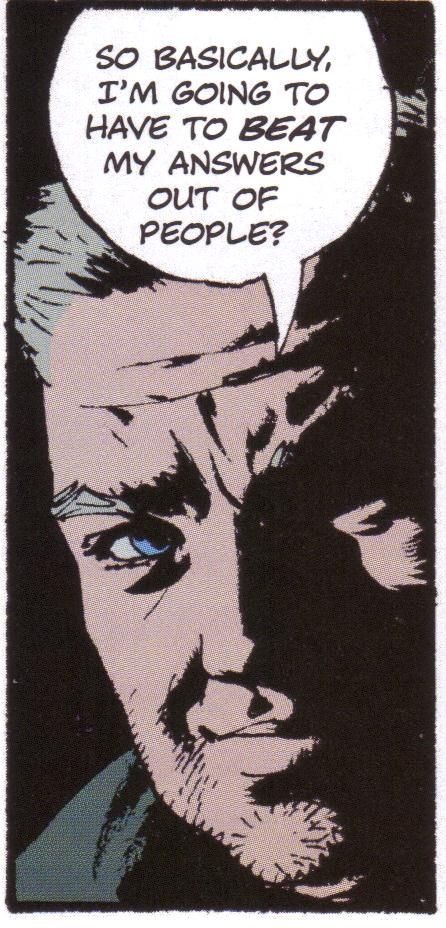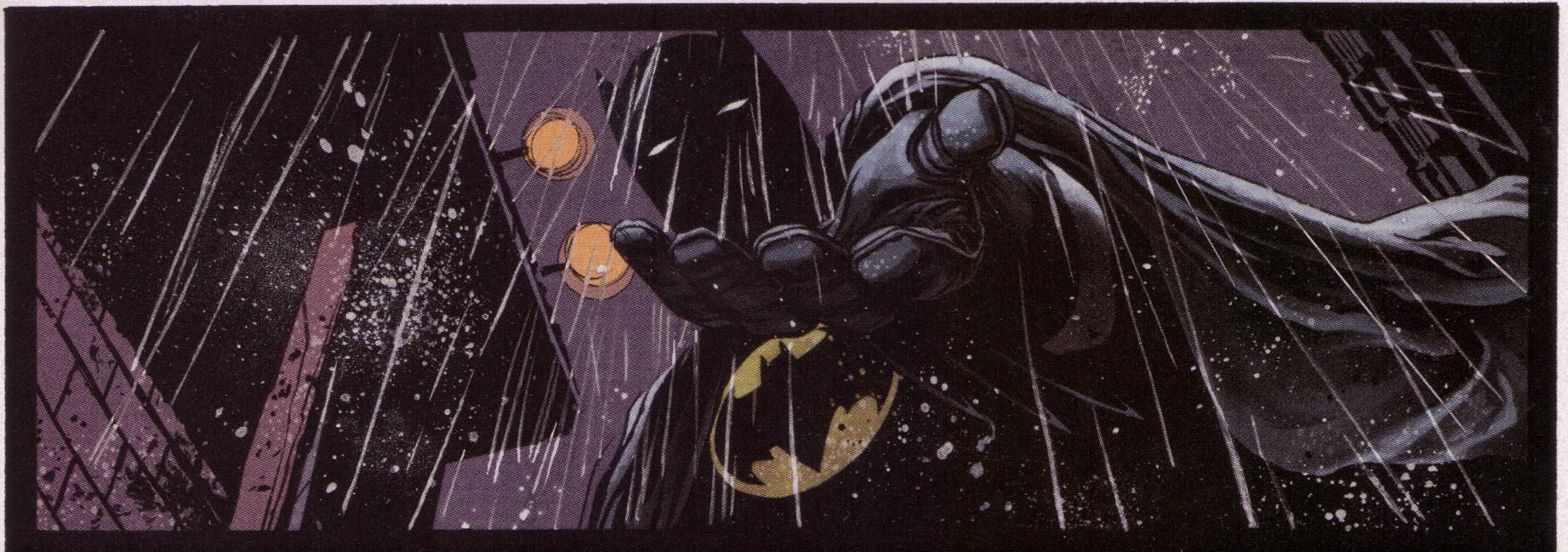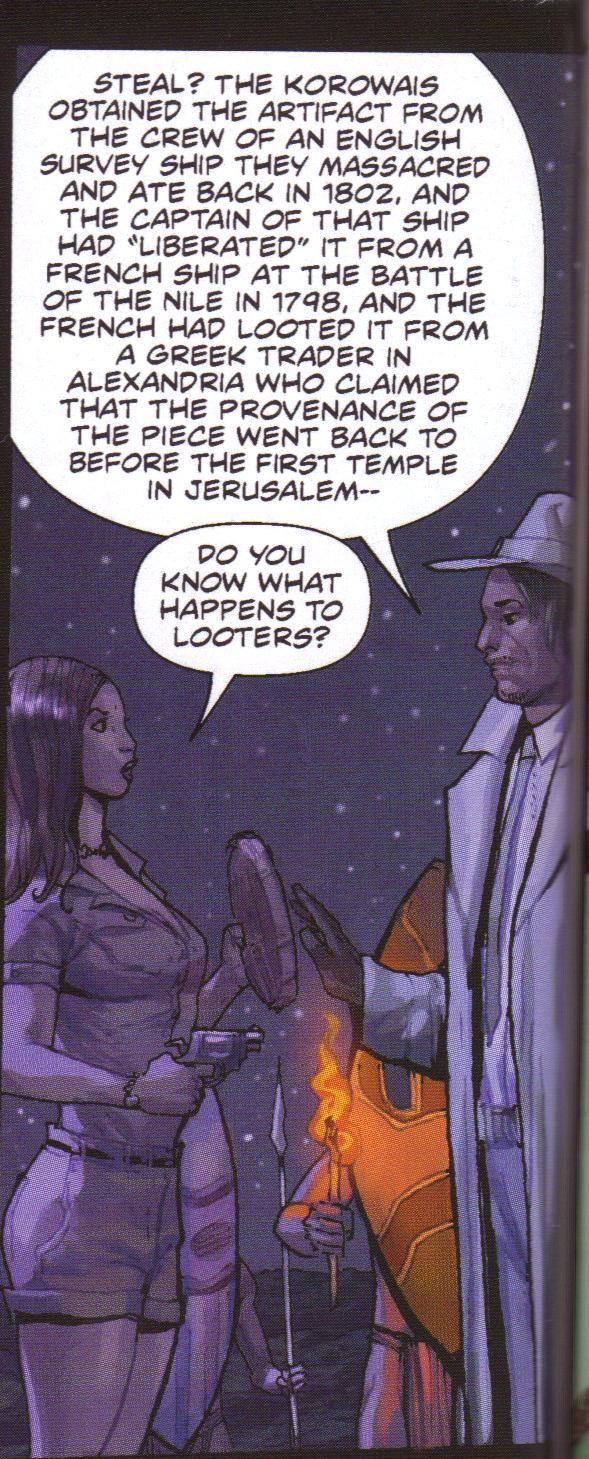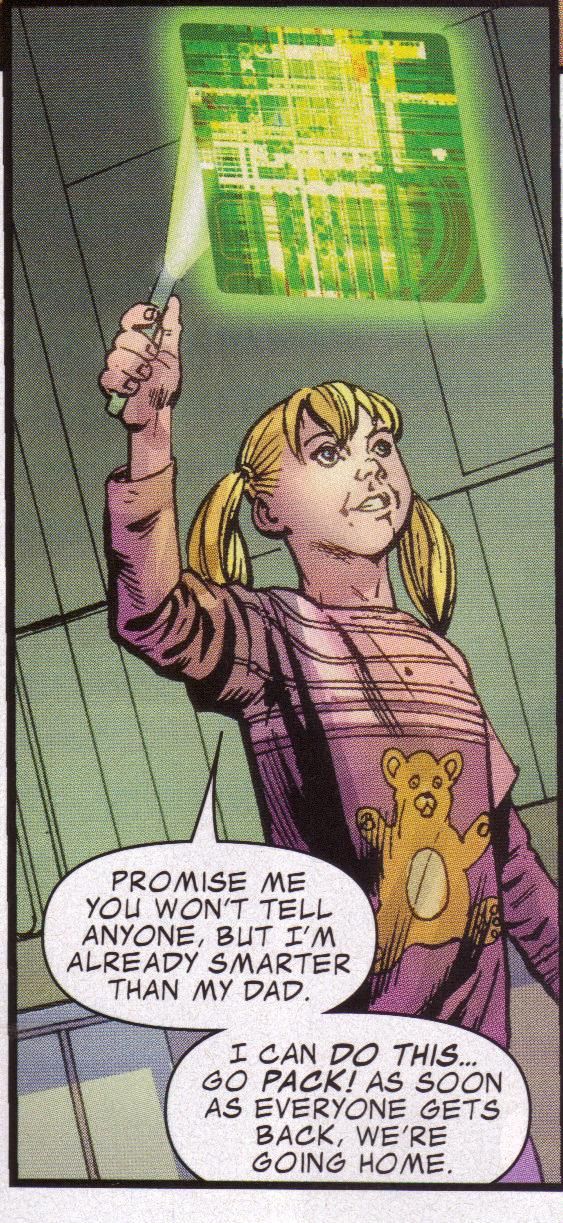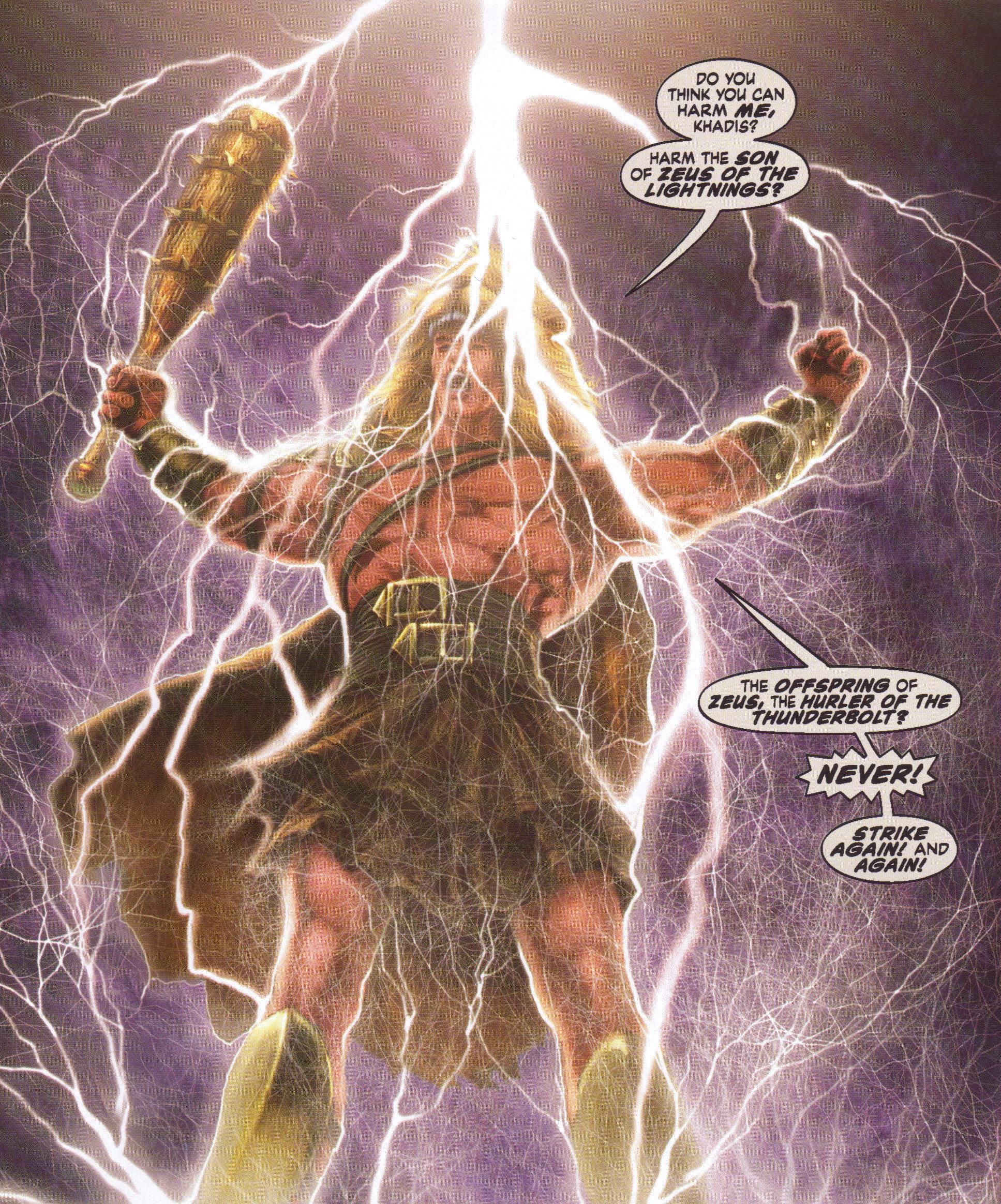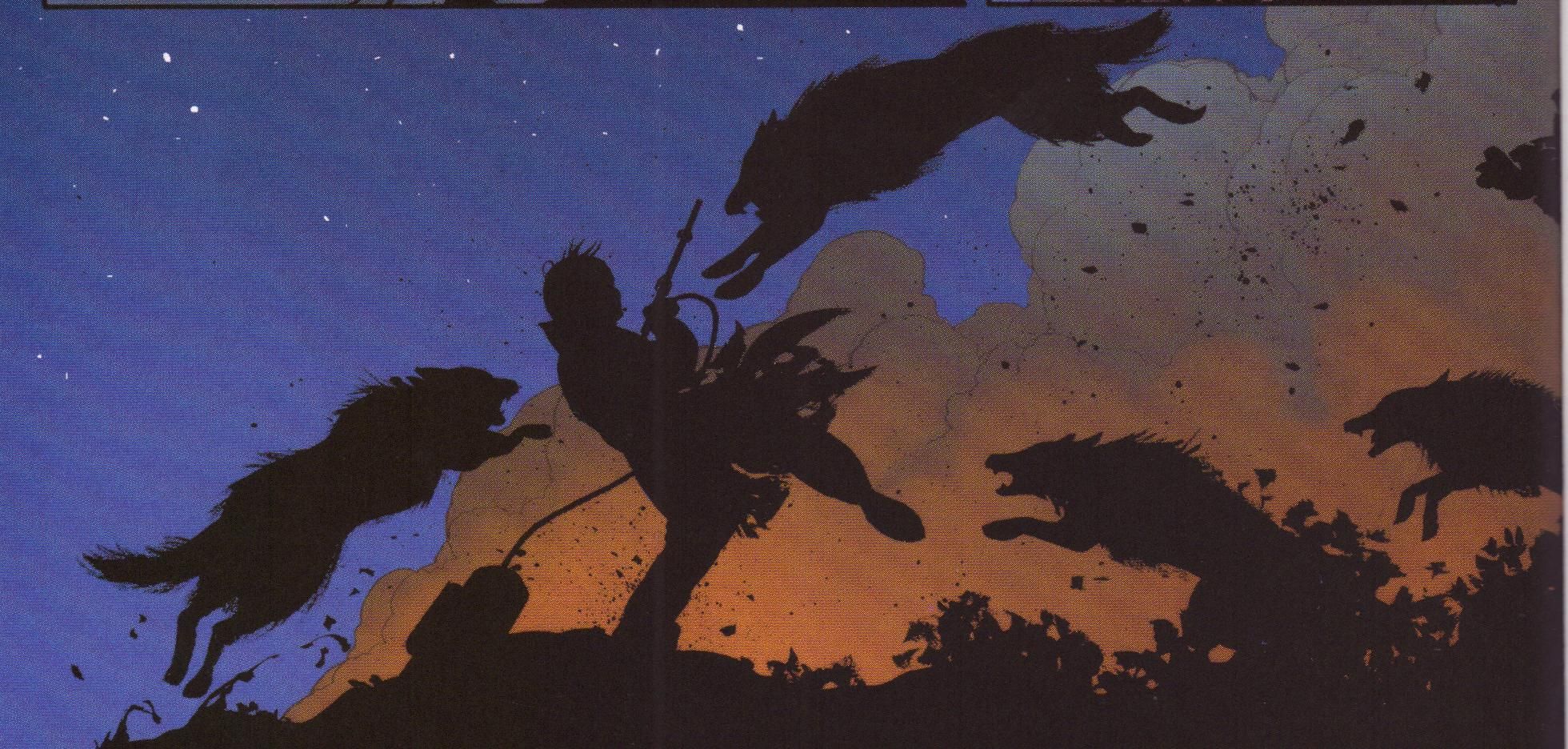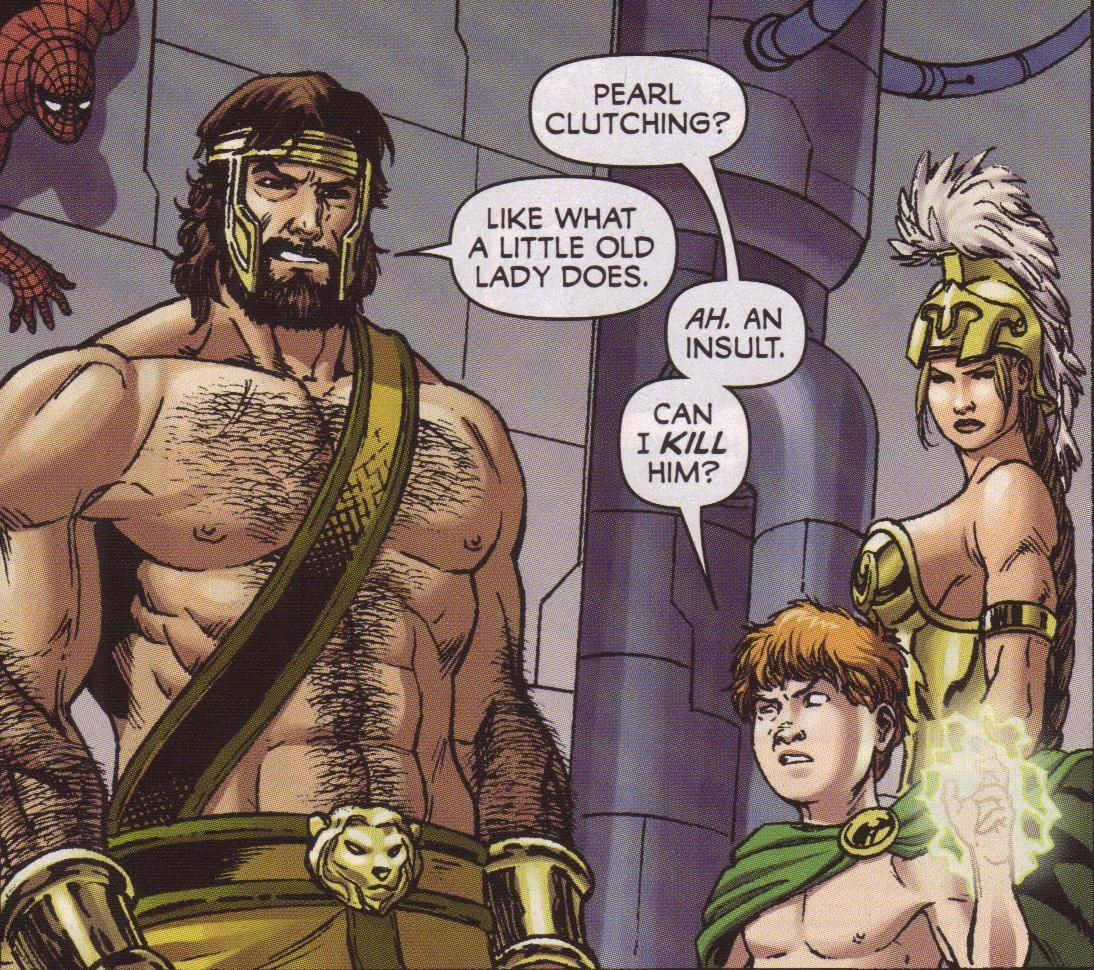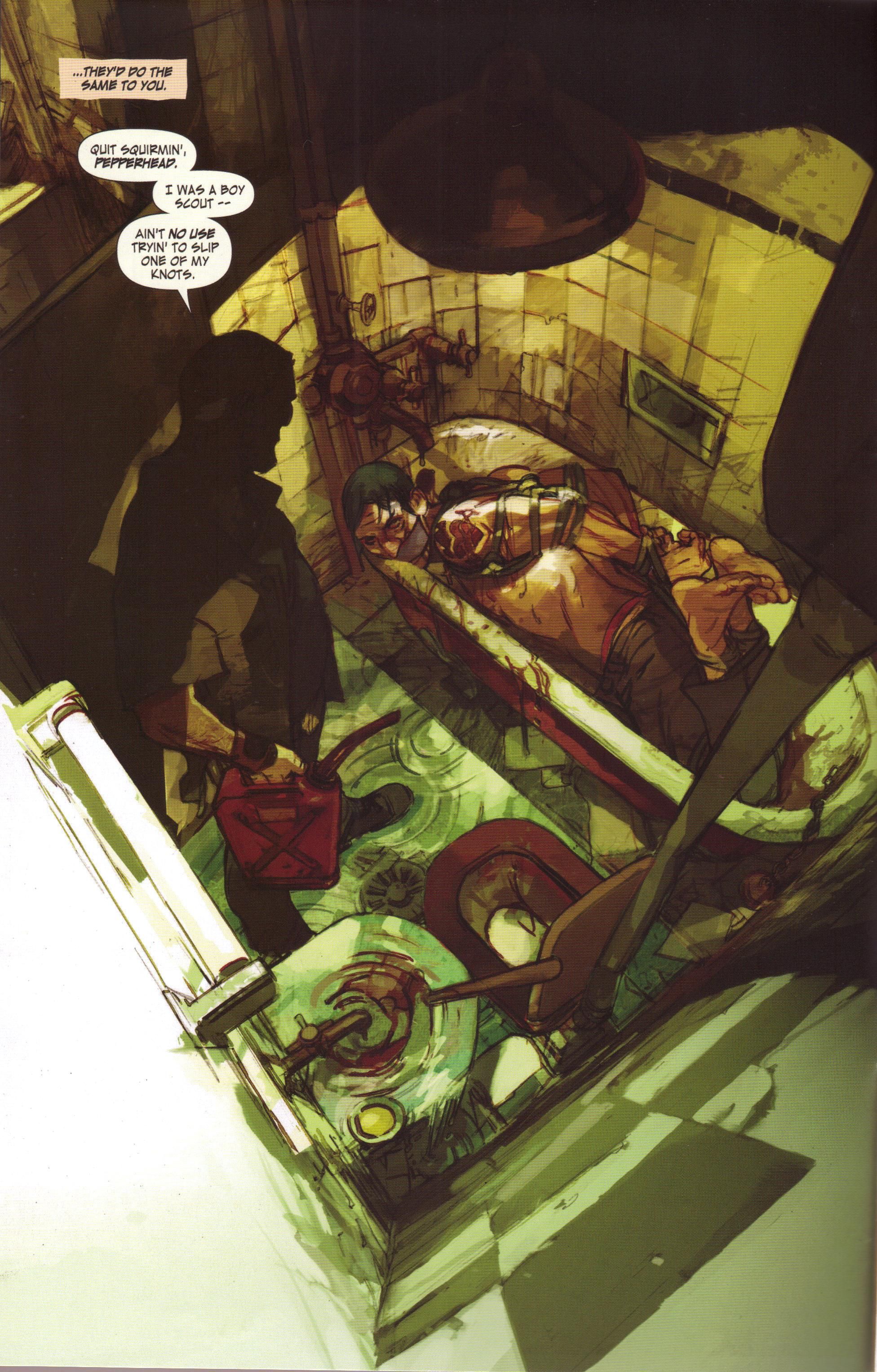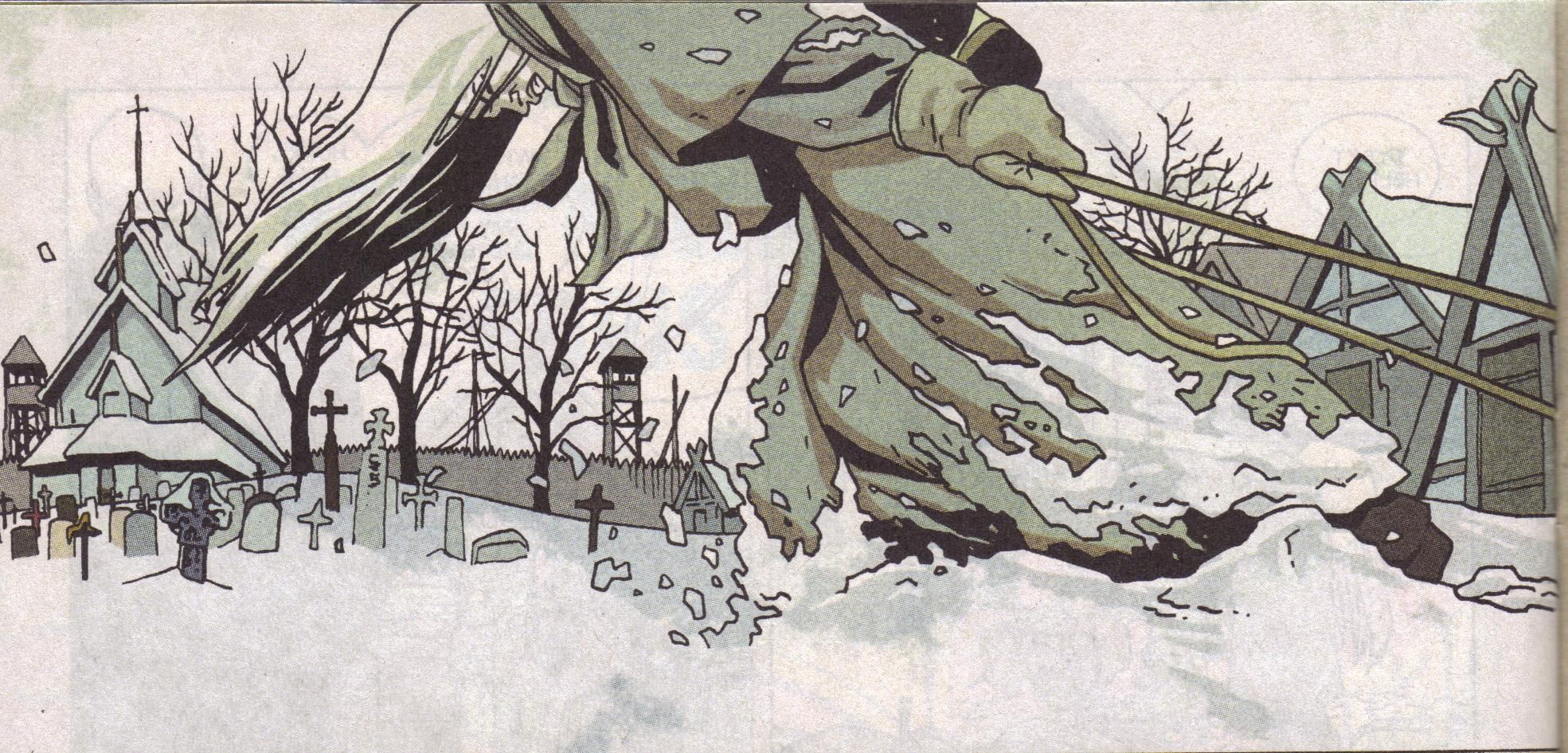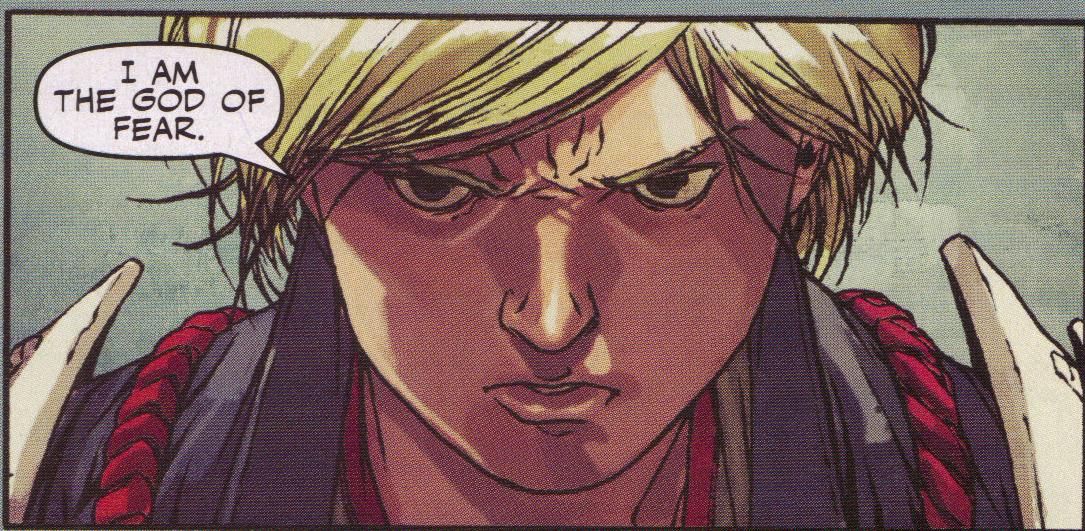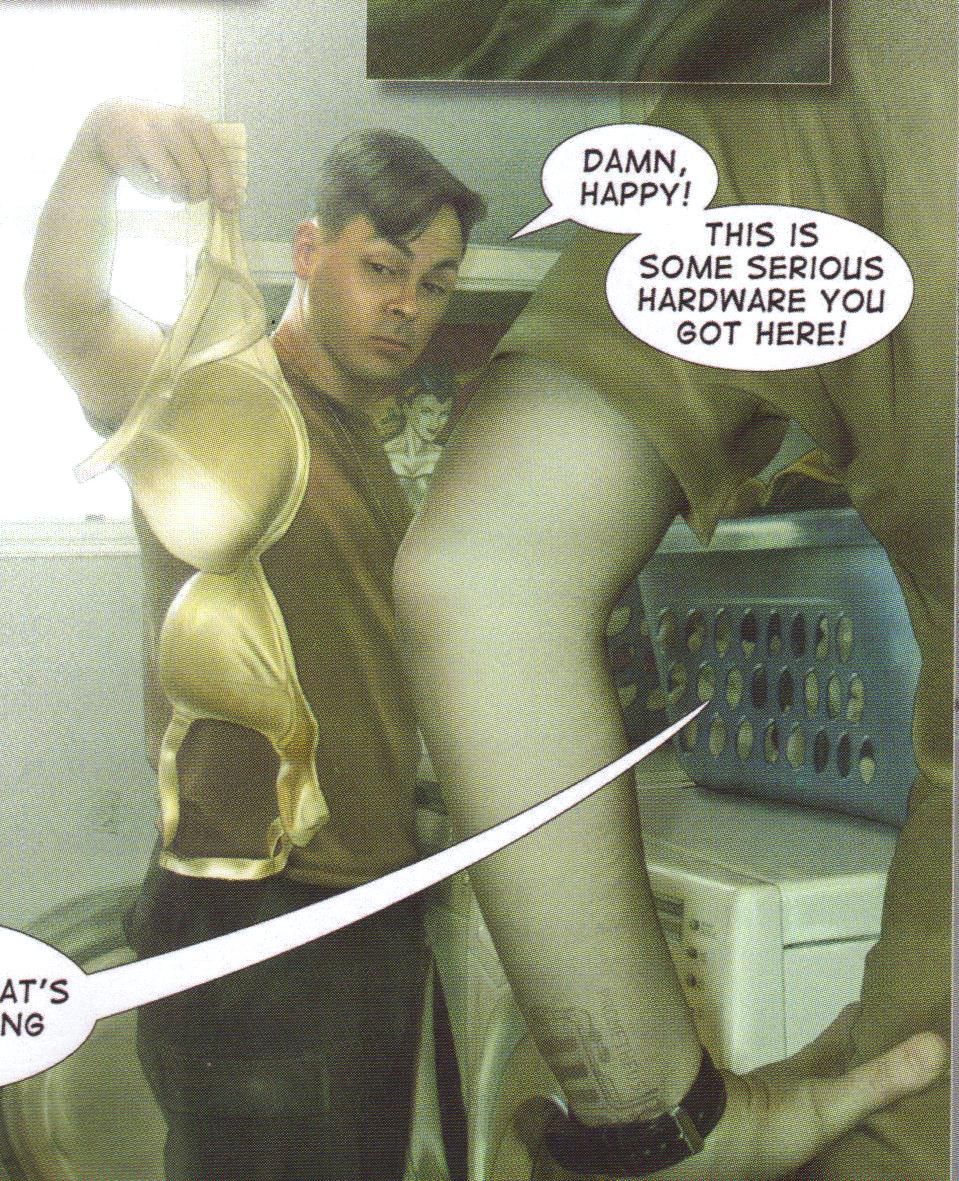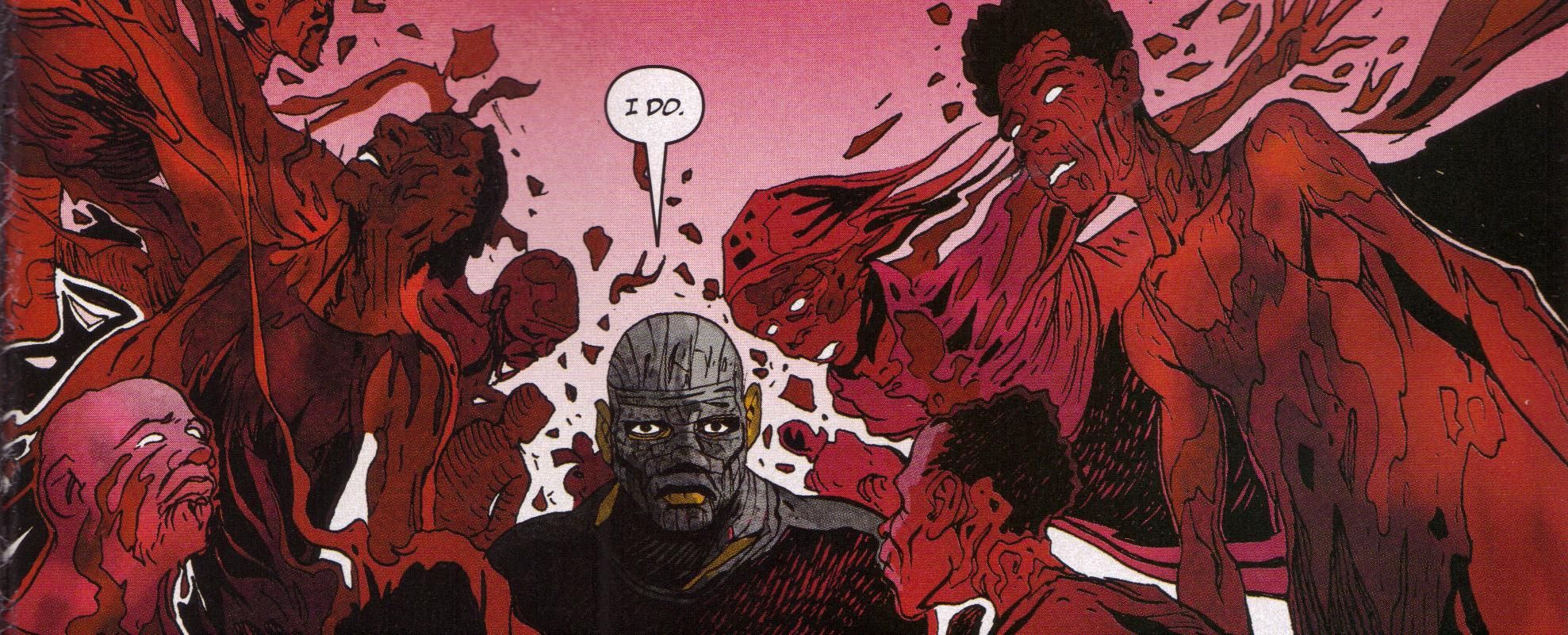I remember when I was in love, I broke my sword upon a stone, and bid him take that for coming a-night to Jane Smile; and I remember the kissing of her batler and the cow's dugs that her pretty chopp'd hands had milk'd; and I remember the wooing of a peascod instead of her, from whom I took two cods, and giving her them again, said with weeping tears, "Wear these for my sake." We that are true lovers run into strange capers; but as all is mortal in nature, so is all nature in love mortal in folly.
I didn't buy all of these - two were sent to me - but dang, that's a grip of funnybooks, ain't it?
Beasts of Burden #3 (of 4) ("Something Whiskered This Way Comes") by Evan Dorkin (writer), Jill Thompson (artist), and Jason Arthur (letterer). $2.99, 22 pgs, FC, Dark Horse.
Dorkin continues to tell nifty short stories that feature the core cast of characters, yet still add some elements that, presumably, will pay off down the road (if the series continues). In this issue, Orphan goes into the sewer to find a cat he's convinced is not dead. Well, of course she isn't, and Orphan and another cat, the Getaway Kid, discover some pretty nasty things down there. I certainly don't want to give too much away, but Dorkin continues to do a wonderful job making these characters true animals but still making them familiar. There are touches of humor as Orphan tries to remain calm in a horrific place, and there's true horror when he discovers what Dymphna - the cat he's rescuing - has been doing. The fact that Burden Hill is such a picturesque place and a sewer is such a mundane location makes the horror more effective, and don't get me wrong - a good deal of this is horrific. It's also extremely gripping.
As for Thompson - well, there's not much else anyone can say about the brilliance of Ms. Thompson. She's magnificent at making the sewer seem darker and more terrifying as Orphan gets closer to his goal, and when he's confronted with the monsters at the end of the quest, Thompson's drawings make your skin crawl. One panel near the end shows how good she is at all sorts of emotions, as we get a beautiful painting of ... well, I won't ruin it, but it's very sweet. Thompson, not surprisingly, remains terrific on this title.
This comic is very good, mainly because Dorkin balances the horror with hopefulness, and even though terrible things happen to cast members, there's always a sense that good will triumph. We feel like these dogs and cats are holding something evil back (and, of course, they are) and that even if some fall, they will continue to hold the line. It's that hopefulness that makes this a pleasure to read even as we're cringing from some of the more nasty things Dorkin throws at us. I'm keen to see if next issue pulls some plot threads together or if it's another one-and-done story. Either way, it's a series you should be checking out!
One panel of awesome:
Chew #6 ("International Flavor Part 1 of 5") by John Layman (writer/letterer), Rob Guillory (artist/colorist), and Lisa Gonzalez (color flatterer). $2.99, 22 pgs, FC, Image.
Let's consider this cover and compare it to Adi Granov's cover to The Incredible Hercules, which looks carved from marble. Why, if you judge a book by its cover, would you pick the Marvel book over this one? It doesn't feature art that looks anything like what's inside, and it's a pretty boring "Let's attack something off to the side here!" kind of thing that doesn't inspire at all. Meanwhile, Rob Guillory draws this cover, which gives you a good idea about what kind of art you'll get inside (if you're too lazy to actually flip through the book), while we get the two principals staring incredulously at something very alien on a beach in which are buried several skulls. Now, this scene doesn't actually appear in the comic, but the thing on the table does play an important role in this issue, so the scene, while not literal, is a nice way to introduce the story arc. Not all Marvel/DC books have as boring covers as Granov's - Alan Davis's FF cover is nifty, while J. H. Williams III actually does the cover AND the interiors of 'Tec - and many non-Big Two books feature a different cover artist than the artist who does the interiors - Darwyn Cooke on The Last Resort is an example, but his covers for that series have been a blast of gory fun - but it just seems like this cover would entice a casual fan much more than many of the Big Two's. I suppose that this issue isn't on as many stands as a Marvel comic, which would explain some of it.
Anyway, Layman and Guillory begin the second arc of this series, and as I've mentioned every time an issue comes out, it's getting better each time. After the events of last issue, Tony gets a new partner, and it's his old partner from the Philadelphia police - John Colby. Colby got a cleaver to the face and had half his visage replaced by bionics, so he looks a bit like Deathlok. Layman gives us some misdirection early on, as he makes it clear that Colby hates Tony because of the whole cleaver to the face incident, but he's just doing it to mess with his boss, and the two get along fine. The boss gives them a case that requires Tony to ... well, see the one panel of awesome below. Tony and Colby decide to solve the crime old-school style, which leads them to a broth made out of that thing on the cover. But what the hell is it? Ah, that's the mystery!
Layman continues to get stronger putting a story together. In the first couple of issues, he was sailing along on the weird character he had cooked up, but over the past few issues, the structure of the issues have become more clever and the actual writing has gotten stronger. This is a very funny comic, from the problem with Tony's prosthetic ear to the banter between Tony and Colby to the way Colby shakes down a guy who knows something about the crime they're investigating. And Guillory is his usual fantastic self, packing each panel with wonderful details and doing wonders with the comic timing of the entire issue. He's marvelous, for instance, when Colby calls the boss and tells him what Tony's doing with the "clue" the bad guys left behind. Tony's reactions to his recitation are wonderful. Almost every panel has something to enjoy, either from Layman's writing or Guillory's art.
If you missed the first five issues, Layman gets us up to speed pretty quickly (although, of course, the end of the first arc is ruined for you, if you care), so it's a fine place to jump on. I liked this series from the beginning, but I'm very happy that it's getting better and better. Isn't that groovy?
One panel of awesome:
Criminal: The Sinners #2 by Ed Brubaker (writer), Sean Phillips (artist), and Val Staples (colorist). $3.50, 30 pgs, FC, Marvel/Icon.
Here's why I could never be a criminal: In this comic, Tracy gives Sebastian Hyde's daughter an innocuous ride home and Hyde happens to see it. As he's a suspicious criminal, he seems to think something underhanded is going on. Instead of asking Tracy about it, I imagine he'll just assume the worst. Because he's a criminal, don't you know. I'd just hate to live my life consumed by suspicions like that.
Anyway, Brubillips continue to knock these issues out of the park, as Tracy wanders around the city trying to figure out who killed Hyde's men. Of course, now that one of the victims is a cop, the other cops are on the case, which complicates things, and the dude looking for Tracy as a deserter is still around. The great thing about this series is that Brubaker always takes his time and simply allows plot point to pile upon plot point without forcing it. The thing with Sabrina Hyde feels important, but it just happens, and even though Brubaker doesn't pay it off in this issue, it's still there - a seemingly innocent occurrence that is sure to have important consequences later. Brubaker does this extremely well, and it's what makes Criminal such an entertaining read.
I shouldn't have to mention how good Phillips is, but I will. We get his usual wonderful job, but I'd like to point out one excellent attention to detail: Phillips draws the hooker with very saggy breasts, and although we only see them completely (and covered) in one panel, it's such a nice way of showing how this woman's life has turned out. Most of the time in comics, even when the writers write good female characters, artists draw them to be attractive. The hooker isn't ugly, but Phillips makes it clear that her lifestyle has taken its toll. And I'll praise colorist Val Staples again, because colorists don't get enough love: The lurid reds and greens and pinks of this crime-ridden landscape help turn Phillips's rough city into a weird, almost surreal world, and it's extremely impressive. It's very keen.
Whenever I read an issue of Criminal, I curse Brubaker and his back matter writers because of all the movies they make me want to see. I've never seen Bullitt, which Brubaker praises in a short piece in the back, but now I want to see it and the two other movies he discusses, Robbery and The Friends of Eddie Coyle. Plus, the Australian noir Ryan Lindsay writes about sound cool, too. Damn you, Brubaker!!!!
One panel of awesome:
Days Missing #4 (of 5) ("April 21st, 1519") by Matz (writer), Hugo Petrus (artist), Imaginary Friends Studios (colorist), Caravan Studio (colorist), and Troy Peteri (letterer). $2.99, 22 pgs, FC, Archaia/Roddenberry.
Petrus does a good job roughing up this series after the previous three issues were a bit slick (which worked for Frazer Irving's art but not so much with, say, Chris Burnham's), and it makes the Steward's journey to visit Hernan Cortez look a bit more authentic, for lack of a better word. We get a good sense of the Spaniards' trekking through the jungle and fighting against the Aztecs. The story doesn't work quite as well, even though it's not bad. Matz does a pretty good job making Cortez a sympathetic character and shows how each choice we make can lead to greatness or depravity, but because Matz uses a day on which the historical events are pretty much the same as what happens in the book, it doesn't seem to have as much of an impact. The Steward, as we see on the cover, burns Cortez's ships, but then decides he must excise himself from history, and Cortez, in his infinite wisdom, co-opts the ploy. The Steward claims he does this to stop Cortez, but there are plenty of places where he could have stopped Cortez, and burning the ships is not a good place to do it. I appreciate Matz's attempts to view the conquest of Mexico in a different way, but the actual plot of the book doesn't feel right. Oh well.
One panel of awesome:
Detective Comics #859 ("Go Part 2" and "Pipeline: Chapter Two Part One") by Greg Rucka (writer), J. H. Williams III (artist, "Go"), Cully Hamner (artist, "Pipeline"), Dave Stewart (colorist, "Go"), Dave McCaig (colorist, "Pipeline"), Todd Klein (letterer, "Go"), and Jared K. Fletcher (letterer, "Pipeline"). $3.99, 30 pgs, FC, DC.
I'll get to Rucka in a moment. First, let's appreciate the genius of Williams once again, as he once again apes Mazzuchelli in "Year One" to give us the next installment of Kathy Kane's maturation into Batwoman, and those final few panels, where Batman appears before Kathy when the mugger attacks her and Williams shows both styles blending together, are wonderful. It's the past meets the present (so to speak, as it's still the "past") and Williams does a beautiful job with it. Stewart's use of red and black throughout the book is a nice touch, too. I still think the animal/human things look a bit silly, but Williams does as good a job as he can, I suppose. The real treat with the "present" scenes, as usual, is the layout of the page. Williams always makes them fun to look at.
Rucka's writing on this arc is stronger, but I thought of something while I was reading the scene between Kathy and Renee. Rucka, of course, likes women and likes lesbians, and it's no surprise that the scene when the two of them chat is well written. It made me wonder how often we see a scene like this between a man and a woman in a mainstream superhero comic. It seems like it doesn't happen that often, and I wonder if it's because male writers are somehow reluctant to show men as either sensitive, vulnerable, petty, or simpering. Interestingly, both Kathy and Renee exhibit all of those traits during a two-page scene, and it makes the scene very real and powerful. Usually, male-female intimate scenes in superhero comics are treated as a prelude to sex (here, it's post-coital, although Kathy wants it to be inter-coital) or even done for laughs. I rarely read, say, Fantastic Four, but Reed and Sue's conversations rarely seem to touch on sex except in the vaguest of ways, as when Sue makes a joke about Reed's stretchability. We often rant about how male writers can't seem to write women well. Should we be wondering why they can't write men well either?
Finally, can we stop with comic book characters randomly quoting philosophers or writers and having the other character guess who it is wrongly just so the writer can prove how clever he is? I get that the dude in the Question story is so goddamned smart that he would know quotes by both David Hume and Seneca, but it's kind of annoying. Why would Renee guess Seneca anyway? I've read plenty of Renee Montoya stories (not too many recently, though), and I have no sense that she would know Seneca. It's just Rucka showing off. I know I'm quoting a snooty writer at the beginning of this post (guess who it is!), but I looked the damned thing up. Because I too am showing off - my skills at looking things up! Whoo-hoo! Maybe I'm just tired of feeling dumb. That could be it.
One panel of awesome:
The Devil's Handshake by Ryan Schifrin (writer), Larry Hama (writer), Adam Archer (artist), Lizzy John (artist), and Ed Dukeshire (letterer). $5.95, 42 pgs, FC, Archaia.
This is a fun tale that seems set in the wrong time. Basil and Moebius are two ne'er-do-wells (Basil is actually a guard at the Tower of London) who are being forced to work for a mysterious man called the Collector who tasked them to, well, collect things. We're introduced to them in New Guinea, where they're trying to secure an "artifact" possessed by the natives. Things, of course, have already gone FUBAR, and the natives are about to throw them into a pit of lava. They're also at odds with two weird man-monsters called the Ghoul Brothers, who want the artifact for themselves. And, of course, there's a sexy chick with a low-cut shirt who's not exactly what she seems. Isn't that always the way? Basil and Moebius fail to retrieve the artifact (the sexy chick gets it), but they track it to Libya, where they discover its secret. And, of course, the Collector is not all he seems either. All's well that (sort of) ends well, and while Schifrin and Hama tell a fairly complete story, they also leave the situation wide open for many more tales of the two adventurers.
For the most part, it's a fun and exciting romp, as Basil and Moebius use their brains and brawn and bicker like an old married couple. They both think they have a shot with Sophi (and of course, one of them ends up sleeping with her) and they have a good time arguing over her. This is one of those comics where it's obvious the two male leads are meant for each other but they spend their time chasing an elusive woman. It's actually fun to read it that way. It's in the grand tradition of Raiders of the Lost Ark and other pulp adventures, with some nice supernatural touches thrown in. Schifrin and Hama don't exactly re-invent the wheel, but they do a good job with it all. I've never been a fan of Hama (I've never read his G. I. Joe work, but when he wrote for the X-books, I wasn't impressed at all, and I read a few of his issues of Detective and hated them), but the writers here do a good job mixing the lightness and some darker aspects of the book.
Archer is quite good, with a distinct Daniel Acuña vibe (I'm not the hugest fan of Acuña, but neither do I hate him). He obviously has a good time drawing the women in the book (Sophi, of course, but also Moammar Khadafi's elite all-female Amazonian Guard ... and no, I'm not kidding - fret not, though, as they're dressed in relatively normal military gear), but he does a nice job with the exotic settings and some of the creepier things in the book. Even though his faces often look a bit too plastic, he manages to give the characters some nice emotional responses to situations.
The weirdest thing about this comic is that it's set in the present day. It feels like a 1930s pulp novel, but it's set today. Therefore, we get references to Khadafi and Victoria's Secret and texting, which just feels ... weird. I mean, in the beginning, the native of New Guinea are dressed in loin cloths and wearing big ceremonial masks as they get ready to chuck our heroes into the volcano. I've never actually been to New Guinea, so who am I to say they wouldn't do that, but it just seems like such an unlikely thing to happen in the 21st century. (On a side note, I recently met a woman who is staying in Mesa for a year in between missionary ventures to New Guinea. If I ever see her again - she took her kids to the same park where I was with Norah - I'll have to ask her if the natives hang out in loin cloths and chuck thieves into volcanoes.) It certainly doesn't ruin the comic, but it does have a weird vibe to it.
I'm not completely sold on The Devil's Handshake, but it does look great and has a ton of energy in it. You could do a lot, lot worse, I'll tell you that much.
One panel of awesome:
Fantastic Four #573 ("Adventures on Nu-World") by Jonathan Hickman (writer), Neil Edwards (penciler), Andrew Currie (inker), Paul Mounts (colorist), and Rus Wooton (letterer). $2.99, 22 pgs, FC, Marvel.
As much as I like Alan Davis, I have no idea what that cover is supposed to be showing. I mean, it's all about Franklin's birthday, and he and Valeria stowing away with Johnny and Ben when they go to Nu-World, which I imagine this cover is supposed to portray, but it's just so jarring in tone with what's inside that it's bizarre. I don't really care too much, it's just a bit weird.
Edwards does a pretty decent job filling in on this issue, although something bugs me about his art that I can't quite put my finger on. Seriously. This is why I'm a lousy reviewer - I'm way too vague sometimes. I can't figure out what bugs me, but for the most part, I like it. Not as much as Eaglesham's, but that's why he's a fill-in artist! Hickman, shockingly, gives us a single-issue story, so if you've been hearing good stuff about Hickman's work on FF, here's your chance to dip into it without a big commitment! Hickman does what he can with Nu-World, a dumb concept from the Millar/Hitch run, and it's nice to see Reed nowhere in the picture. Franklin narrates the story, so we know that everything is going to be fine, but Hickman manages to wring some pathos out of the fate of Nu-World. I was under the impression that Franklin was a bit smarter than he's written here, but maybe Valeria's genius puts him in a bad light. What's nice about an issue of Fantastic Four when Reed isn't around is that the science fiction is still there but without the obnoxious attitude of the team's leader. And because Nu-World is like an Elseworlds, Hickman can do some more "permanent" stuff with the characters, and he takes advantage of that.
This is a keen little story. It's the kind of story that Hickman seems to excel at. I'm curious to see what's up for next issue before the next big arc.
One panel of awesome:
Hercules: The Knives of Kush #4 (of 5) by Steve Moore (writer), Cris Bolson (artist), Manuel and Leonardo Silva (artists), Doug Sirois (colorist), Cliff Cramp (colorist), Steve Firchow (colorist), and Todd Klein (letterer). $2.99, 24 pgs, FC, Radical Comics.
The fine folk at Radical were nice enough to send this to me, and it's quite cool of them. I was curious to read this, because I read the first issue but not the next two, so I wanted to see if I could get back into the story even with the gap in my comic knowledge. We get a quick recap of the story so far, and throughout the book, Moore does a decent job filling us in on some of the gaps someone like me might have. It's a pretty decent job of getting readers who might have come in late up to speed.
I've read quite a few Radical books, and while I think Hotwire is my favorite so far, the two Hercules mini-series aren't far behind. Moore has done a good job capturing the world of ancient Greece and the Eastern Mediterranean, from the weird cults to the sudden violence to the lack of clothing. As this issue is the penultimate one in the series, the two opposing forces - one of Pharoah Seti II, the other of his brother - clash, and Moore does a very nice job showing all the preparations for it - the Egyptians placate their gods, and the Greeks wonder why they're so weird and don't sacrifice animals - and the actual battle. As with the last mini-series, Hercules and his band discover that maybe Seti isn't the best boss in the world, but they're committed. Moore does a good job with the alien nature of the ancient world, which is very much like ours in some ways and very different in other ways.
I'm not as big a fan of the art, because it's in the same vein as many of Radical books, with a painted sheen that robs the art of much dynamism. However, Bolson and his collaborators do a very good job when the battle between Hercules and Khadis begins, leading to one panel of awesome (see below). It's still not great, but the effect when those two fight is impressive.
I don't know if I'm going to get the final issue. We'll see!
One panel of awesome:
I Am Legion #6 (of 6) by Fabien Nury (writer), John Cassaday (artist), Laura Martin (colorist), Justin Kelly (translator), and Crank! (letterer). $3.50, 28 pgs, FC, Devil's Due/Humanoids.
I still don't quite understand the delay with this mini-series, as it was completed years ago and at least partially translated years ago. I can't figure it out, but I guess that's why I don't work for a comic book company.
I was going to re-read the first five issues, because this is a fairly dense series and there are a lot of characters whose names I've forgotten, but I remember the gist of it, which is that an ancient Slavic evil - the strigoi - is trying to do ... well, something. It involves a plot to kill Hitler and a conspiracy that involves Churchill, but what's important is that the good guys face off against the strigoi on two fronts and Cassaday draws the shit out of it. This entire mini-series has looked absolutely terrific, and it makes me sad that it appears Cassaday has moved beyond drawing interiors. Because he's, you know, really good.
Anyway, I'm glad this comic is finally done. It's pretty neat. And it looks fantastic.
One panel of awesome:
The Incredible Hercules #138 ("Assault on New Olympus, Part I: Playing Gods" and "Godmarked Part 2: Remember the Titans?") by Greg Pak (writer, "Playing Gods"), Fred van Lente (writer, "Playing Gods"), Jeff Parker (writer, "Remember the Titans?"), Rodney Buchemi (artist, "Playing Gods"), Gabriel Hardman (artist, "Remember the Titans?"), Guillem Mari (colorist, "Playing Gods"), Wil Quintana (colorist, "Remember the Titans?"), Simon Bowland (letterer, "Playing Gods"), and Tom Orzechowski (letterer, "Remember the Titans?"). $3.99, 29 pgs, FC, Marvel.
This is a more straightforward superhero issue than we usually get from these creators, as they drop a lot of the fun and stick to the bashing of bad guys. That's not to say there aren't some fun lines (USAgent confidently thinking he can easily deal with the "chicks" inside Olympus; Spidey quoting Ghostbusters) and only a few but still excellent sounds effects ("Brevoooorted" is the best one), but it's not quite as brilliant as the usual issue, and I think it's because Pak and van Lente are slowly tying this into "Siege" and, as we know, a crazed psychopath who used to dressed in a Halloween costume attacking a mythical home of the gods is deadly goddamned serious business! It's still an enjoyable issue, to be sure, but it lacks a little bit of the spark we usually see. Of course, whenever I say that, the next issue is excellent, so we'll see. Buchemi does a good job, even though I hate the bowl cut he gives Amadeus. Ares torn between going to battle and screwing Aphrodite is a nice panel.
The Agents of Atlas back-up continues the story of our heroes rescuing Venus from the clutches of Phorcys, the giant octopus god. They do, of course, and then head back to New York to check out ... the Olympus Group. Oh, the long skeins are all coming together! The story is six pages long and feels a bit rushed (Phorcys seems to give up pretty easily), but it gets everyone where they need to be, so that's dandy. And Hardman's art, as usual, is really, really good.
I'm still excited about the whole "Assault on New Olympus" thing, even if it's tying into "Siege," in which I have no interest. I just hope both Herc and the Agents of Atlas get a higher profile from this event. That would be nice.
One panel of awesome:
The Last Days of American Crime preview by Rick Remender (writer), Greg Tocchini (artist), and Rus Wooton (letterer). 10 pgs, FC, Radical Comics.
I also received this preview in the mail, which was also cool of Radical. They're heavily promoting this title, which comes out soon (I thought it was in November, but it appears it will be in December). Anyway, soon.
The Last Days of American Crime is Rick Remender's heist comic, and from the preview and the interview with Remender in the back, it doesn't sound too different from any other heist story. That's not necessarily a bad thing, but the thing that makes this different - it takes place in the near future, and the government is about to switch from paper currency to charge cards, and our thief is going to steal a card machine before they go on-line - isn't that original, so we'll have to see about that. Remender tells the interviewer that the government is about to "broadcast a mind-altering signal" that will keep anyone from knowingly committing a crime, so our thief - Graham Brick - is forced to speed up his timetable. That's presumably what's going on in the 10 pages of the preview, in which he tortures a guy to find out who he's told about the job. Everything is already going to hell!
It's very difficult to judge, based on these few pages, whether Remender will do anything interesting with this set-up. The idea of the government switching from paper currency to charge cards without revolution breaking out seems a bit far-fetched, but perhaps Remender addresses that. Remender has a fairly decent track record, so if you're enjoying his run on Punisher, for example, you might want to check this out. The star of the preview is Tocchini, whose work is very good. He has a Dustin Nguyen thing going on, which is perfectly fine with me. Tocchini does a nice job with Remender's blighted landscape - this looks like it could take place today, but we can also easily believe it's a few years in the future. The book looks like a crime noir story, and that's half the battle. And unlike a lot of Radical comics, it doesn't have the glossy sheen of computer effects - Tocchini may have used a computer, but it doesn't look like it - which is nice.
I'm still not sure whether I'm going to get this series, but it does look pretty neat. If you're into heist stories, that is!
One panel of awesome:
The Last Resort #4 (of 5) by Jimmy Palmiotti (writer), Justin Gray (writer), Giancarlo Caracuzzo (artist), and Chris Mowry (letterer). $3.99, 22 pgs, FC, IDW.
Gray and Palmiotti's gleefully perverse series continues, as we finally learn what the hell is going on and (possibly) how a rescue will happen (the rescue could turn into a clusterfuck, after all, in a book like this). The survivors come up with a plan to last the night, and a few more people die. The Last Resort remains a wonderfully gory treat, with a nice dollop of sex thrown in. This is the kind of book in which, when we turn the first page, we get a drawing of a generously endowed naked woman bent over a control panel while a tall Teuton gives it to her doggy style while she says, and I'm quoting word for word here, "Shut up and fuck me, you Nazi prick! Give me your wunder waffe!" How can you not love a comic like that?
It seems like all the despicable people have been dispatched, although with such a large cast, it's a bit hard to tell, so I might actually feel bad if some of the survivors die (which, of course, some will). I even have a soft spot for the people who just want to smoke weed and screw before their inevitable death, even if they do something a bit lousy in this issue. Palmiotti and Gray even take some time for a geniunely sad moment - one that often shows up in horror stories, but still. And Caracuzzo continues to make the gore jump right off the page, which is always nice to see.
I'm not sure how this will all end, but it's a very fun ride.
One panel of awesome:
Northlanders #22 ("The Plague Widow Part 2 of 8: Heads of Household") by Brian Wood (writer), Leandro Fernandez (artist), Dave McCaig (colorist), and Travis Lanham (letterer). $2.99, 22 pgs, FC, DC/Vertigo.
Wood does some nice work with exposition in this issue, as we learn more about the settlement and Hilda's place in it, but the real drama in this issue comes from Fernandez, as he draws Hilda ... pulling supplies. Who would have guessed that would be such a dramatic scene? Gunborg, the big ugly dude who runs the settlement's protection rackets, demands her tithe, but she doesn't believe it will all end up in the common stores, so she offers to take it to the lord herself. As her husband was quite wealthy, this turns out to be quite a bit. But Hilda is undeterred! Fernandez does a magnificent job showing her drag it across the snow toward the main longhouse, and although it only lasts five pages, it feels like a tremendous and epic journey across hundreds of miles. It's an amazing sequence, and Fernandez does a wonderful job with it.
There's more going on than that, of course, as Wood shows that the village is more split than we originally thought and that Hilda has allies everywhere, but all that will play out in the coming issues. In this one, we just have to appreciate Fernandez making Hilda's trek through the town so excellent.
One panel of awesome:
Secret Warriors #10 by Jonathan Hickman (writer), Alessandro Vitti (artist), Sunny Gho (colorist), and Dave Lanphear (letterer). $2.99, 23 pgs, FC, Marvel.
Secret Warriors is a weird comic. It's not a bad comic, but I'm not sure what exactly it's supposed to be. The first arc was all about Nick Fury building an army to fight Norman Osborn. This arc, by contrast, has been about Nick's superhero people fighting Osborn's Avengers, but it's been kind of all over the place, leading to this issue, which focuses on Alexander and his father, Ares. It's an entertaining issue showing Alexander's relationship with Ares through the centuries, leading to Alexander and Ares showing up at the "council elite of the Earth's pantheons," where Alexander will account for who he is. Hickman does a nice job with it (and lets us know that Secret Invasion ended five weeks ago, in case you were wondering), but it feels a bit far afield for this comic. I suppose Hickman, like Pak and van Lente, is steering us toward "Siege," which is fine, I suppose, but I would like to read a comic about Nick Fury taking down Osborn through backhanded methods. But maybe that's just me.
One panel of awesome:
Titanium Rain Double Size #2 ("Actual" and "Drift Factor") by Josh Finney (writer/artist) and Kat Rocha (artist). $4.99, 47 pgs, FC, Archaia.
Archaia was nice enough to send me this (they also sent me Days Missing and The Devil's Handshake, but I bought those anyway), even though I wasn't totally jazzed by the first issue. And guess what? I'm still not jazzed by it. As I mentioned last issue, I really can't deal with the creepy "realistic" art, where we get actual people scanned into a computer. I don't like it and probably never will. When Finney and Rocha stick to the non-human components of the book, it works a bit better, but it's still very difficult art to warm up to.
The story is a bit better, because Finney gives us the end of the dogfight that concluded last issue and then explains how the war started in the first place. The pacing of the issue (which, of course, was supposed to be two issues) works fairly well, because we get the excitement in the beginning and then, once you're hooked, Finney finally fills us in on why American pilots are fighting in China. The writing itself isn't too great, as Finney often falls into clichés, but the way China falls into war makes a certain amount of sense.
I'm always keen to read stories set in the future that flow somewhat naturally from current events, and this certainly qualifies. Finney's story is perfectly fine (despite the issues with the writing), and I really wish the art didn't repel me so much. Oh well. This issue is more interesting than the last one, so I guess that's progress!
One panel of awesome:
Unknown Soldier #14 ("The Way Home Chapter Two of Two") by Joshua Dysart (writer), Pat Masioni (artist), José Villarrubia (colorist), and Clem Robins (letterer). $2.99, 22 pgs, FC, DC/Vertigo.
This turns out to be a fairly crucial issue of Unknown Soldier, as Dysart brings Moses to an important point in his life. Last issue, he began to take the kid, Paul, back to his village, and in this issue, he finishes that task and discovers that Paul has secrets of his own and the village might not be as welcoming as he thought. The theme of this issue is forgiveness and whether Paul and Moses and the villages can move beyond the past and embrace a different path. What Dysart does with Moses now promises to be interesting, because he's been thrashing around for a year or so (in our time, of course) and now he seems to have cleared his head and therefore needs a new mission. Dysart doesn't overdo the writing in this, allowing us to experience Moses's redemption more viscerally, and Masioni does a good job with some of the more dream-like qualities of the issue. I'm not totally in love with Masioni's art - his figures are a bit too stiff - but with the more surreal aspects of the book, he's quite good.
Dysart continues to make this a fascinating book, especially when he focuses on Moses himself and his journey through this war-torn land. Even though the Ugandan conflict forms the backdrop of the comic, Moses and his internal conflicts are what drives the book, and it's nice to see Dysart bring part of that conflict to a conclusion instead of dragging it out. It opens up future issues to other paths, and I'm keen to see where Moses goes after this.
One panel of awesome:
Well, that's a ton of comics. But let's get on to other things! Earlier this week we drove down to beautiful Tucson, where we stopped at the Pima Air and Space Museum. We did not go to the airplane graveyard made famous in Can't Buy Me Love (man, I love that movie) because the last tour of the day had left, but we did check out some of the airplanes, including one near and dear to the hearts of comic book fans:
Yes, that's a SR-71 Blackbird, long-time mode of travel for the X-Men. Let me tell you, that thing is gigantic. And it somewhat strains the limits of credulity to think that they had an endless supply of them, as they often destroyed them. I can't imagine how much one of those things cost, much less the dozens Xavier and his clan went through! Oh well - it's fantasy! I had never been to Tucson before, but something struck me as odd. In one of the main plazas in town, between two of the main drags, is a statue of Pancho Villa. Why, oh why, is there a statue of a man whose main claim to fame for Americans, at least, is his infamous invasion of the United States? I can understand a statue to him in Mexico, but why on earth would the residents of Tucson approve a statue of Pancho Villa in their town? It's very weird. I guess they had their reasons!
Anyway, let's check out some totally random lyrics:
"Well I never said I wouldn't
Throw my jacket in the mud for you
But my father gave it to me
So maybe I should carry you
Then you said 'You almost dropped me'
So then I did
And I got mud on my shoes"
Isn't that always the way? I hope everyone who celebrated Thanksgiving and is reading this had a good one!

